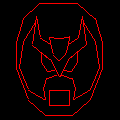Gammapedia is archived. No new edits are allowed and no new accounts can be registered.
Vector: Difference between revisions
mNo edit summary |
main method |
||
| Line 16: | Line 16: | ||
public class VectorTest { | public class VectorTest { | ||
Vector crocs = new Vector(); | public static void main(String[] args) { | ||
Vector crocs = new Vector(); | |||
crocs.add("Your [[Teh Face|Face]]"); | |||
crocs.add(new Integer(5)); | |||
crocs.add("[[internets]]"); | |||
crocs.remove(1); | |||
System.out.println(crocs.get(0)); // Your [[Teh Face|Face]] | |||
System.out.println(crocs.get(1)); // internets | |||
} | |||
} | } | ||
==See Also== | ==See Also== | ||
* [[Vector Crocs]] | * [[Vector Crocs]] | ||
[[Category: Simple]] | [[Category: Simple]] | ||
Latest revision as of 00:19, 19 September 2006

The Vector class implements a growable array of objects. Like an array, it contains components that can be accessed using an integer index. However, the size of a Vector can grow or shrink as needed to accommodate adding and removing items after the Vector has been created.
Each vector tries to optimize storage management by maintaining a capacity and a capacityIncrement. The capacity is always at least as large as the vector size; it is usually larger because as components are added to the vector, the vector's storage increases in chunks the size of capacityIncrement. An application can increase the capacity of a vector before inserting a large number of components; this reduces the amount of incremental reallocation.
As of the Java 2 platform v1.2, this class has been retrofitted to implement List, so that it becomes a part of Java's collection framework. Unlike the new collection implementations, Vector is synchronized.
The Iterators returned by Vector's iterator and listIterator methods are fail-fast: if the Vector is structurally modified at any time after the Iterator is created, in any way except through the Iterator's own remove or add methods, the Iterator will throw a ConcurrentModificationException. Thus, in the face of concurrent modification, the Iterator fails quickly and cleanly, rather than risking arbitrary, non-deterministic behavior at an undetermined time in the future. The Enumerations returned by Vector's elements method are not fail-fast.
Note that the fail-fast behavior of an iterator cannot be guaranteed as it is, generally speaking, impossible to make any hard guarantees in the presence of unsynchronized concurrent modification. Fail-fast iterators throw ConcurrentModificationException on a best-effort basis. Therefore, it would be wrong to write a program that depended on this exception for its correctness: the fail-fast behavior of iterators should be used only to detect bugs.
This class is a member of the Java Collections Framework.
Example
import java.util.Vector;
public class VectorTest {
public static void main(String[] args) {
Vector crocs = new Vector();
crocs.add("Your Face");
crocs.add(new Integer(5));
crocs.add("internets");
crocs.remove(1);
System.out.println(crocs.get(0)); // Your Face
System.out.println(crocs.get(1)); // internets
}
}